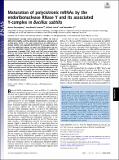Postsynaptic actin regulates active zone spacing and glutamate receptor apposition at the Drosophila neuromuscular junction
Author(s)
Walldorf, Uwe; Xu, Ke; Zhong, Guisheng; Zhuang, Xiaowei; Blunk, Aline Dorret; Akbergenova, Yulia; Cho, Richard W.; Lee, Ji Hye; Littleton, J. Troy; ... Show more Show less
DownloadE5585.full.pdf (2.544Mb)
PUBLISHER_CC
Publisher with Creative Commons License
Creative Commons Attribution
Terms of use
Metadata
Show full item recordAbstract
Synaptic communication requires precise alignment of presynaptic active zones with postsynaptic receptors to enable rapid and efficient neurotransmitter release. How transsynaptic signaling between connected partners organizes this synaptic apparatus is poorly understood. To further define the mechanisms that mediate synapse assembly, we carried out a chemical mutagenesis screen in Drosophila to identify mutants defective in the alignment of active zones with postsynaptic glutamate receptor fields at the larval neuromuscular junction. From this screen we identified a mutation in Actin 57B that disrupted synaptic morphology and presynaptic active zone organization. Actin 57B, one of six actin genes in Drosophila, is expressed within the postsynaptic bodywall musculature. The isolated allele, actE84K, harbors a point mutation in a highly conserved glutamate residue in subdomain 1 that binds members of the Calponin Homology protein family, including spectrin. Homozygous actE84Kmutants show impaired alignment and spacing of presynaptic active zones, as well as defects in apposition of active zones to postsynaptic glutamate receptor fields. actE84Kmutants have disrupted postsynaptic actin networks surrounding presynaptic boutons, with the formation of aberrant actin swirls previously observed following disruption of postsynaptic spectrin. Consistent with a disruption of the postsynaptic actin cytoskeleton, spectrin, adducin and the PSD-95 homolog Discs-Large are all mislocalized in actE84Kmutants. Genetic interactions between actE84Kand neurexin mutants suggest that the postsynaptic actin cytoskeleton may function together with the Neurexin-Neuroligin transsynaptic signaling complex to mediate normal synapse development and presynaptic active zone organization. Keywords: Actin; Synapse; Spectrin; NMJ; Cytoskeleton; Neurexin
Date issued
2014-07Department
Massachusetts Institute of Technology. Department of Biology; Massachusetts Institute of Technology. Department of Brain and Cognitive Sciences; Picower Institute for Learning and MemoryJournal
Molecular and Cellular Neuroscience
Publisher
Elsevier
Citation
Blunk, Aline D. et al. “Postsynaptic Actin Regulates Active Zone Spacing and Glutamate Receptor Apposition at the Drosophila Neuromuscular Junction.” Molecular and Cellular Neuroscience 61 (July 2014): 241–254 © 2014 Elsevier Inc
Version: Author's final manuscript
ISSN
1044-7431
1095-9327